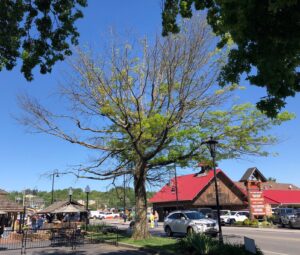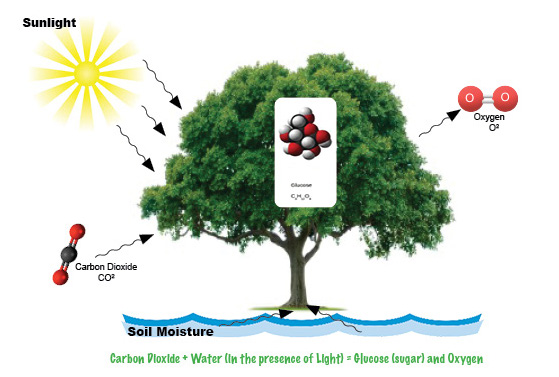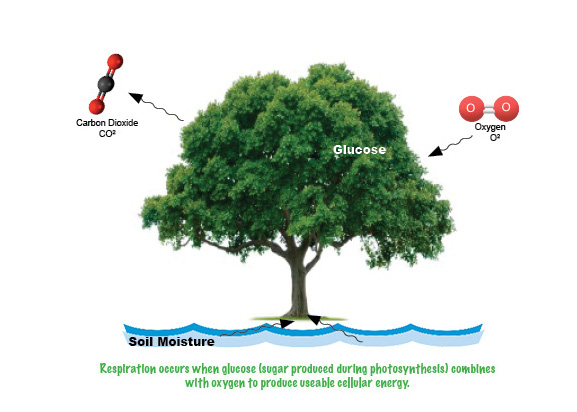It’s tough out there for trees, especially when they are trying to survive in the “un-natural” urban forest where we live. Trees grow very well on more natural, undisturbed sites like our forested areas. However, trees planted in suburban and urban areas require more care and maintenance to keep them thriving. Some tree species can live over 300 years, but in the urban environment 25-50 years is the average, according to recent research. If trees don’t receive adequate care, especially during times of stress, they will decline and die much too soon.
- Trees with limited soil volume and supplemental irrigation will decline.
- Successive years of decline will lead to dieback and eventually death of the tree.
There is much speculation on why trees finally just go past the point of no return and die. There are many causes of tree death, but the most common is environmentally induced death often aggravated by some opportunistic pest. However, how the tree dies, well, that’s a scientific and physiological process.
Despite decades of research on plant tolerance to environmental stressors, especially drought, the physiological mechanisms by which trees succumb are a continuous point of examination. However, it could be argued that two main reasons trees experience a physiological death is starvation and thirst, lack of food and water. Actually, it’s more complicated than that from a tree’s perspective.
The important factors responsible for tree death are carbon starvation and hydraulic failure. When the energy resources in the form of complex carbon molecules become exhausted, the tree can no longer support respiration, which is the use of carbohydrates to create energy. This can happen when the tree is depleted due to the inability to photosynthesize which creates simple sugars or carbohydrates. If storage or sink areas are depleted as well, there are no reserves which the tree can draw upon. This can occur from several stressful growing seasons leading to an “overdrawn food account”. Food sources are created through photosynthesis. Photosynthesis is a process by which phototrophs convert light energy into chemical energy, which is later used to fuel cellular activities. The chemical energy is stored in the form of sugars, which are created from water and carbon dioxide.
This chemical process is seasonal and light dependent. Sugar is broken down through the process of respiration, this is the key process. If the tree can’t break down the sugar into key products such as cellulose and starch for energy, the tree just runs out of fuel and begins the decline spiral. It’s a very specific chronological process in which photosynthesis creates the energy source and relies on respiration to oxidize the carbohydrates for food. The tree then relies on translocation, which requires water and nutrient movement through the plant vascular system, allocating these resources throughout the plant.
The process of respiration is constant, even in dormancy and production of carbohydrates must exceed its energy requirements especially during the growing season. Without a surplus of food, decline begins, and death eventually follows, unless conditions improve. Proper maintenance and care means providing adequate moisture and fertility to help maintain healthy growth and energy reserves.
Trees have a vascular system with an amazing transport capacity. The transport system can deliver water rapidly and preferentially to those parts of the canopy which are most actively transpiring or losing water. This is called translocation which is simply the movement of something from one place to another, in this case water and other soluble products. The transport system is subject to the impacts of environmental stress, especially temperature extremes and pests.
Hydraulic failure is the loss of conductivity or the inability to move water to the leaves and food in the form of carbohydrates around the tree. This means the tree cannot adequately translocate water and assimilates. Water is an important component of many plant processes and is the single most limiting ecological factor for survival. PSN and RESP are no exception to this factor. This translocation of critical resources must occur, or the tree suffers the consequences.
It is well-documented that trees can die of both hydraulic failure and carbon starvation, and that during drought, the loss of conductivity and carbohydrate reserves can also co‐occur. Basically, it is about the trees inability to absorb and translocate water and running out of energy. There are many other factors that can accelerate tree mortality included insects and diseases. Often, physiological stress in trees are signals to pests. This lethal combination of stress and pests will cause rapid decline and death.
So why do trees die? Their death follows a reverse sequence of physiological processes. Trees die because respiration is terminated. Respiration ceases because carbohydrate production ceases and stored carbohydrates are exhausted. Carbohydrate production ceases because photosynthesis has stopped because of lack of functioning green, leafy tissue. Typically, these factors for photosynthesis have been interrupted because of anthropogenic impacts locally or negative environmental changes.
The primary management focus for sustainable long-lived trees is to promote healthy growth which support robust plant processes with adequate oxygen, water, and nutrition in a suitable soil volume. Often a very tall task to accomplish! Also, the timing of maintenance activities such as pruning has an impact on energy production. Pruning in early summer, prior to the possibility of water deficits can reduce the impacts of loss of green tissue. This is especially important if the tree is already suffering from environmentally induced decline. Timing is everything for arboricultural practices and abiding by the physiological demands of the tree is important for sustainable health and growth. The basic needs are critical for all life to be fulfilled to be healthy, trees are no different.
It is important that we all work to protect and enhance our urban forests and community trees by recognizing the resources available to us. Trees in our cities are critical to our quality of life and as stewards of our environment, we must be vigilant for the many issues that imperil our community trees. For more information visit:
Indiana Arborist Association



